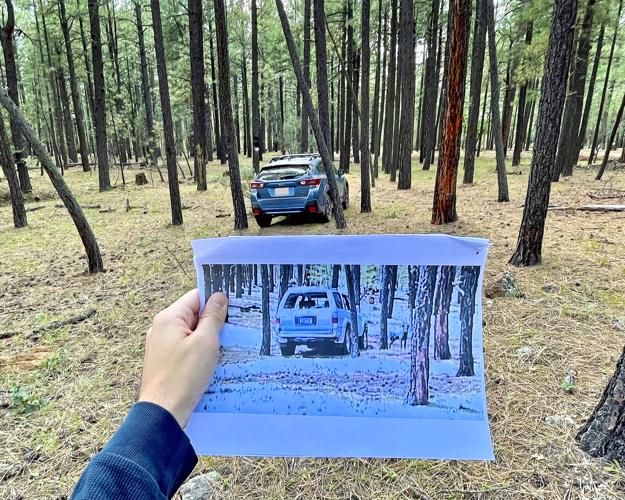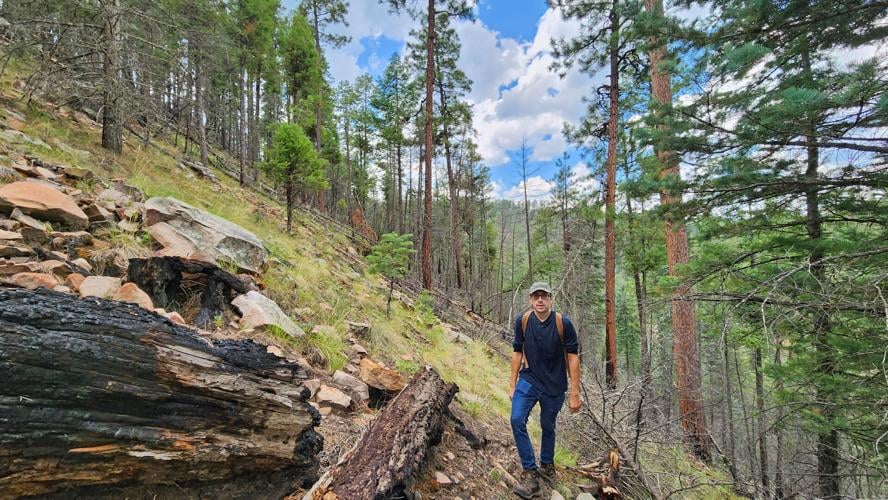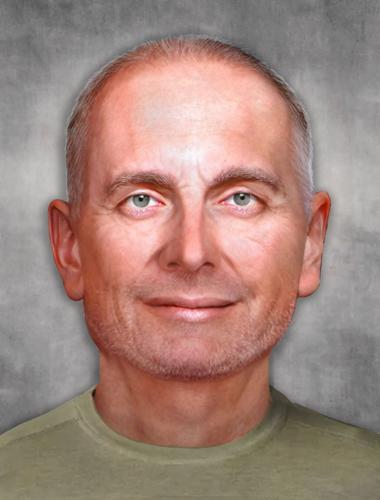A horrific murder with ties to Tucson is getting a fresh look in a new true-crime podcast that aims to finally solve the 23-year-old case.
On April 10, 2001, emergency crews rushed to a house in Scottsdale after it exploded into flames. Inside, investigators found the bodies of Mary Fisher, 38, her daughter, Brittney, 12, and son, Bobby, 10. All three had their throats cut, and Mary was shot in the head.
The lone suspect was Robert William Fisher, the woman’s 40-year-old husband and father to the children. He disappeared after the murders and was never found — at least not yet, anyway.
“I think Robert Fisher is alive,” said investigative journalist Jon Walczak, producer and host of the new podcast. “I think Robert Fisher is alive, I think he escaped, and I think that is a very common belief among many of the investigators involved in the case.”

Investigative journalist and podcaster Jon Walczak hikes in Tonto National Forest in 2023 near the spot where murder suspect Robert Fisher’s vehicle was found abandoned in 2001.
“Missing in Arizona” debuted on iHeartPodcasts and other platforms on Aug. 7, followed by Episode 2 on Aug. 14.
Walczak said another 14 installments are scheduled for release each Wednesday through November.
Fisher was born in Brooklyn but spent part of his childhood in Tucson, where he graduated from Sahuaro High School.
He and Mary reportedly met here for the first time at a church youth conference in the late 1970s, when they were both teenagers. The two later reconnected and eventually married.
“Robert Fisher’s origin story is in Tucson,” Walczak said.
First on scene
Police declared Fisher a suspect three days after the explosion and fire at the family’s Scottsdale home.
A week later, the Fishers’ Toyota 4-Runner was found more than 100 miles away, abandoned among the trees in Tonto National Forest near the community of Young.

A 2001 photo of the Fisher family’s Toyota 4-Runner is shown in 2023 at the same spot where the vehicle was found abandoned in Tonto National Forest, about 100 miles northeast of Scottsdale.
Fisher would be added to the FBI’s Ten Most Wanted List the following year and stay there until 2021, when he was bumped from the lineup by a more recent fugitive.
Author and journalist Tom Zoellner was living in Scottsdale and working for The Arizona Republic at the time of the murders.
“I was the first reporter on the scene when the house blew up,” Zoellner said. “I thought it was going to be a cops brief.”

A new age-enhanced rendering of murder suspect Robert Fisher, produced by forensic artist Michael W. Streed, for the new true crime podcast “Missing in Arizona.” If Fisher is still alive, he would now be 63 years old.
Then the three bodies were found, revealing a “profoundly disturbing” scene of “family annihilation,” he said.
Zoellner ended up chasing the story for weeks, as the high-profile investigation gradually went cold. Little about the case had changed two decades later, when he revisited it in “Rim to River,” his 2023 book about Arizona.
And now Zoellner is among those interviewed for the “Missing in Arizona” podcast, though he doesn’t share Walczak’s view that Fisher is still out there somewhere, waiting to be caught. He thinks the murderer is long dead, probably somewhere not too far from where his vehicle was found — a place sufficiently remote that his remains were lost or scavenged by animals before they could be found.

Author and journalist Tom Zoellner
“I’ve always believed he took his own life,” he said, though no evidence has yet been found to prove it.
“This case has bothered every cop and journalist who ever worked on it, and that there may never be any answers is the most maddening part of all,” Zoellner said.
Reward refreshed
Walczak has spent the past two years researching the case. For four months last summer, he traveled around Arizona retracing Robert Fisher’s movements, talking to people who knew the family and tracking down potential new witnesses and unpublished images of Fisher.
He said he even spent some time hiking and “spelunking into caves” in the forest where the 4-Runner was found.
Walczak said he has interviewed at least 100 people so far — 60 of whom he recorded for the podcast — from the Fisher family’s former neighbors to the local police detectives and FBI agents assigned to the case.
“There’s a lot of new information in this show. It’s not a rehash,” he said.
One of those interviews brought him to Tucson, where he sat down with a friend and former pastor of Fisher, who made a direct plea to him to turn himself in and seek forgiveness from God.
That part of the podcast, Walczak said, is meant for “an audience of one.”
To spur additional interest in the case, “Missing in Arizona” has partnered with Phoenix-area nonprofit tipline Silent Witness to offer a reward of up to $10,000 for information leading to Fisher’s capture or recovery.
Walczak is also asking Gov. Katie Hobbs to use state funds to match the new reward.
“If we solve it, it’s going to be through publicity,” he said.
To that end, he commissioned three forensic artists to create updated, age-enhanced renderings of Fisher, based on publicly available images and previously unreleased photos.
The best of those renderings was chosen for a new wanted poster that Walczak is also featuring in all of the logos and publicity images for the podcast.
“I want people to look at our image, and I want them to look at every man they know who wasn’t in their life prior to April 2001,” Walczak said. If they think there is even a chance that one of those men is Fisher, he wants them to report it to the authorities.
‘Missing’ link
This marks the third title in what has turned out to be Walczak’s “Missing” trilogy, and his second series to heavily feature Arizona.
The podcast investigates the disappearance of Arizona murder suspect Robert Fisher.
His debut 2020 podcast, “Missing in Alaska,” examines a possible link between a Tucson mob associate and the 1972 disappearance of a Juneau-bound charter flight carrying two U.S. congressmen.
“Missing on 9/11” explores the mysterious disappearance of a physician who was last seen on security camera footage a few blocks from the World Trade Center on Sept. 10, 2001, and was added years later to the list of those killed in the 9/11 attack.
The preview for “Missing in Arizona” includes something startling: an introduction from Fisher himself, using a computer-generated version of the man’s voice built from samples of old home movies of the accused murderer.

The logo for the podcast “Missing in Arizona” features a new age-enhanced rendering of murder suspect Robert Fisher.
Walczak used a voice-cloning program called Altered.ai to create his deep-fake Fisher. “We only had 10 minutes of source material, and it was very poor quality,” he said.
In a future episode, the podcaster plans to conduct a carefully scripted “interview” with the fugitive. Walczak said he has no plans to make the fake Fisher talk about the murders or admit his guilt. Instead, they will have a discussion about the ethical implications of artificial intelligence and so-called “synthetic media.”
The use of such technology “might be controversial,” he said, but he sees it as an opportunity to give listeners a taste of what Fisher might still sound like, while asserting some control over a man with a reputation for being controlling and cruel to those closest to him.
In the course of their research, Walczak and company stumbled onto at least one more local connection to the Fisher case: The “Missing in Arizona” crew managed to track down the family 4-Runner that was found abandoned 23 years ago.
Walczak said the vehicle initially ended up with Mary Fisher’s sister in the Phoenix area, before being sold to its current owner. At last check, he said, the 4-Runner was still on the road somewhere in Tucson.








